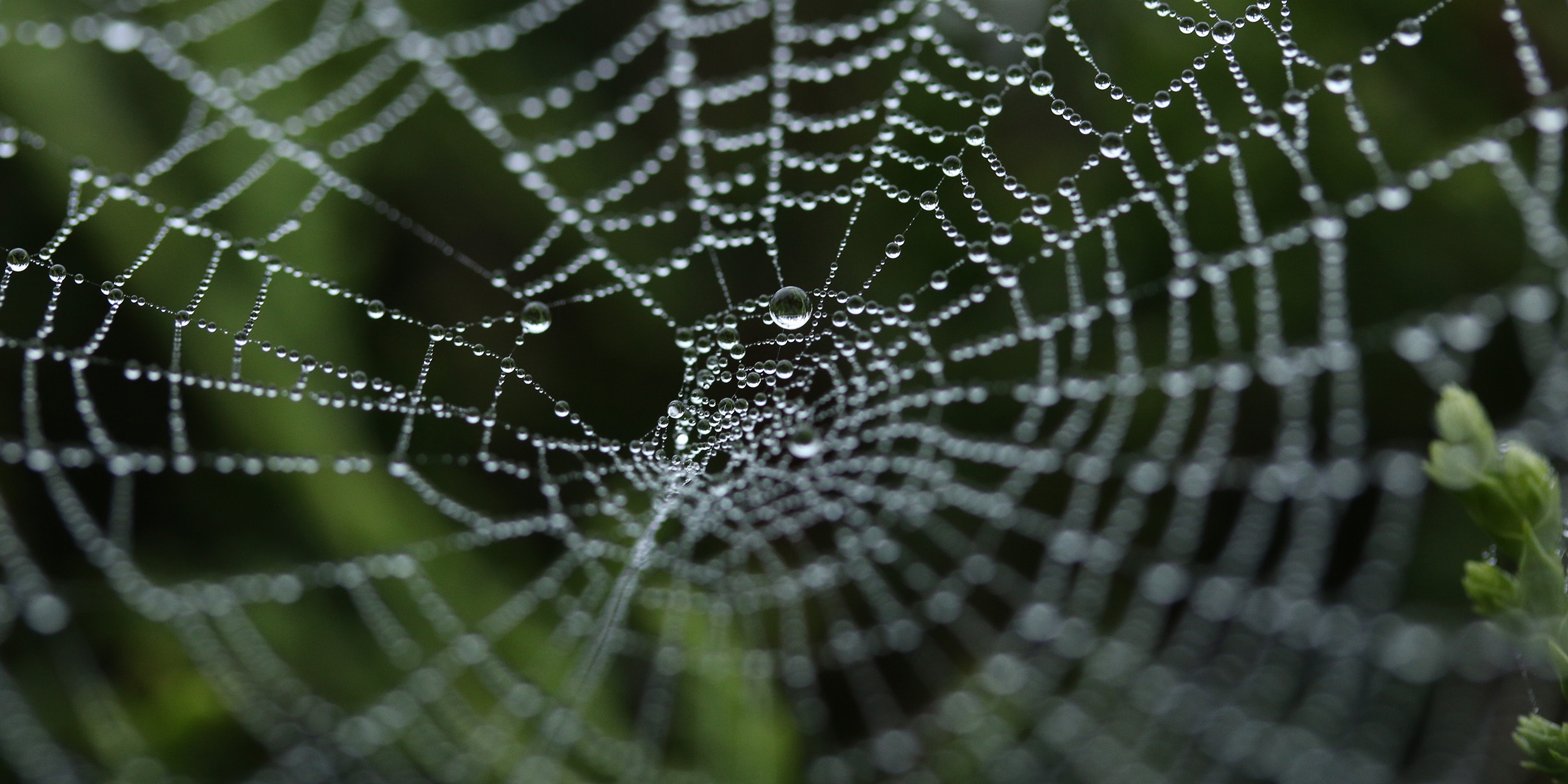Originally published 2 October 1989
On crisp autumn mornings the meadow is a universe of galaxies: spider webs made visible by dew. Star-strung spirals suspended on glistening threads. Tangled silk mats in the grass. Silver funnels, with a spider waiting at each funnel’s black throat.
This is architecture for the belly, silken snares set for dinner. “What refinement of art for a mess of flies!” exclaimed the great entomologist J. Henri Fabre, in his The Life of the Spider. “Nowhere, in the whole animal kingdom, has the need to eat inspired a more cunning industry.”
It is worth getting up early to see the perfection of the spider’s work, before wind, rain, birds, and insects wreak their destructive effect. While you and I slept, the virtuosos of silk were busy. Flinging gossamer strands across the void. Repairing the porches of their burrows. Extending sticky tablecloth traps. And, most spectacularly, spinning spiral webs against the sky.
The spinning of silk is the spider’s greatest accomplishment, a tour de force of evolution. Spiders are born with the weaver’s talent. Hatchling spiders spin webs that rival the finest work of adults. Says Fabre: “There are no masters or apprentices in their guild; all know their craft from the moment that the first thread is laid.”
According to one popular hypothesis, web-building had its origin in the silky line that all spiders pay out behind them wherever they go. Originally, the line served only to help the spider find its way home. After many forays, the mass of threads near the entrance to the spider’s shelter proved useful for another purpose: If an insect touched the sheet of resonant silk, the spider was alerted by vibration, and the prey was soon secured. From this accidental door mat, all future webs evolved.
Fossil spiders
This happened quite some time ago. Fossil spiders with spinnerets (silk glands) on their abdomens are known from the Devonian and Carboniferous periods of Earth history, 300 to 400 million years ago. Fossil silk is not preserved, so we do not yet know when spiders first built webs. Indirect evidence suggests that by the early Cretaceous, 100 million years ago, web-building was well advanced.
In a [August 31, 1989] issue of the journal Nature, Paul Selden of Manchester University describes fossil spiders from 100 million-year-old limestones of north-east Spain. The fossil impressions are richly detailed, almost photographic in quality, and clearly show claws adapted for handling silk and for locomotion on spiral webs. The same limestones contain abundant insect fossils, evidence for ample spider prey. Even then, in the time of the dinosaurs, spiders spun traps of exquisite delicacy — and flourished.
Across millions of years, spiders refined and diversified their craft. A typical garden spider can manufacture as many as eight types of silk, each especially suited for its purpose. Web silk, for example, is different from the silks used for egg sacs and for binding prey.
The familiar orb web of a garden spider consists of two types of silk. The threads radiating from the center are stiff and non-sticky; they provide a strong scaffolding for the web. The circular threads, or capture threads, are elastic and studded with glue droplets; they hold insects fast and stretch without breaking.
Fritz Vollrath and Donald Edmonds of Oxford University have recently analyzed the elastic properties of spider silk (Nature, July 27, 1989). The capture threads of an orb web are especially remarkable. As the spider spins these threads it coats the silk with a viscous liquid. Surface tension causes the liquid to contract into droplets, the way a thin stream of water from a faucet breaks up into drops. As the drops coalesce along the thread, some of the silk is gathered up in bunches within the drops. When the thread is stretched, the silk unwinds from the droplets, like tiny key chains on spring-loaded reels, and then pulls tight back into the drops. The result is a product wonderfully suited for holding insects with virtually unbreakable bonds.
Remarkable elasticity
In the experiments of Vollrath and Edmonds, capture threads were contracted to a twentieth of their length in the web without sagging, and stretched to three times their length in the web without breaking. If human engineers could reproduce these astonishing properties in thread or cable of a larger size, it would be the greatest product to hit the market since nylon.
We often hear it said that science takes the wonder and mystery out of nature. And it is true, I suppose, that the reports of Selden, Vollrath, and Edmonds on spider fossils and spider silk make pretty dreary reading; like all scientific reports, they are couched in technical language and full of tedious numbers and diagrams. But the information contained in the reports only enhances our appreciation of the spider’s craft.
The silky galaxies in the morning meadow seem even more miraculous when we know the properties of the silk, the subtlety of the engineering, and the history of the weaver’s talent. Here, in dozens of glistening webs, the spider composes symphonies of silk. Swiveling spinnerets move in concert with agile claws, devising, measuring, laying down lines, practicing an art learned in the company of dinosaurs, perfected in the planet’s first grassy meadows, and communicated across tens of millions of generations by the ineluctable agency of genes.




I hope the Raymo clan is holding steady in these challenging times. Thinking of you, Chet.
~ Lyra
All is well here. Thank you for thinking of us.